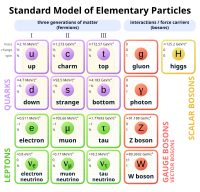
Photo from wikipedia
We calculate the effective potentials of the ΞcD¯(*), Ξc′D¯(*), and Ξc*D¯(*) system s with the chiral effective field theory up to the next-to-leading order. We simultaneously consider the short-, intermediate-,… Click to show full abstract
We calculate the effective potentials of the ΞcD¯(*), Ξc′D¯(*), and Ξc*D¯(*) system s with the chiral effective field theory up to the next-to-leading order. We simultaneously consider the short-, intermediate-, and long-range interactions. With the newly observed Pc spectra as inputs, we construct the quark-level contact Lagrangians to relate the low energy constants to those of ΣcD¯(*) with the help of the quark model. Our calculation indicates there are seven bound states in the I=0 strange hidden charm [Ξc′D¯(*)]J(J=12,32) and [Ξc*D¯(*)]J(J=12,32,52) systems. Our analyses also disfavor the ΛcD¯(*) bound states. However, we obtain three new hadronic molecules in the isoscalar [ΞcD¯(*)]J(J=12,32) systems. The masses of [ΞcD¯]1/2, [ΞcD¯*]1/2, and [ΞcD¯*]3/2 are predicted to be 4319.4-3.0+2.8 MeV, 4456.9-3.3+3.2 MeV, and 4463.0-3.0+2.8 MeV, respectively. We also notice the one-eta-exchange influence is rather feeble. Binding solutions in the I=1 channels are nonexistent. We hope the future analyses at LHCb can seek for these new Pcss in the JψΛ final states, especially near the thresholds of ΞcD¯(*).
Journal Title: Physical Review D
Year Published: 2020
Link to full text (if available)
Share on Social Media: Sign Up to like & get
recommendations!